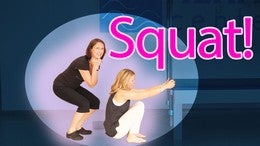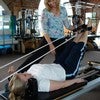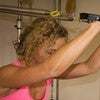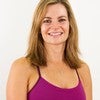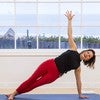Description
About This Video
Transcript
Read Full Transcript
Hello everybody. I'm back at Flonase anytime and super excited about this idea that I have a, this is a bit of a tutorial exploring the pieces needed to more comfortably get into a deep squat. There's a lot of hype these days about the deep squat. And I have to say that I've been very addicted to the feeling of getting down close to the floor and feeling my body just like safely in a little ball. And I think that the biggest challenge for people is that it doesn't always feel good on the body to get there. So I, I want to look today at some of the pieces needed to, um, are some pieces that may help each body get into the position more comfortably. Okay. So we're going to start with the idea of, of working on a little bit of mobility in certain areas and the joints and then we're going to work on functional mobility and strength.
And then we're going to try again for the deep squat and see how it goes. Okay. So what I mean by the deep squat is it's not meant to be a fitness squat. It's not meant to be something you do over and over and over again to strengthen your muscles so much. But it's meant to be a position that allows your body actually to be um, soft. You actually are soft in the deep squat, and it's also quite functional in that if you needed to bend down and pick something up off the ground, your body should work for you in a way that would allow you to do so quite easily. You should be able to fold in on your body and tie your shoe, or quite easily, you should be able to fold in on your body, get to the floor and play with your baby or your animal, whatever it may be. So oftentimes that's not so easy to do.
So one thing I'd like you to, I'd like this to be kind of an experience. So what I'd like you to do, first of all, is have something available to hold on to just in case you really need it, because you might, I don't want you to fall over. I don't want you to feel uncomfortable. I don't want you to feel pain. I want you to feel ease. It doesn't mean it's easy but ease. So you need something to hold onto.
It could be the foot bar of your reformer. It could be a banister, it could be a bed post, it could be a bar, a pole, but something fixed. Okay, so moving forward, we're going to need a tennis ball. That's a must have. Okay? You must have some version of a ball. If it's not a tennis ball, a ball will do, but, but this is my favorite. This one's just purple, yellow. We'll do. And then something like a block, a yoga block. It could be a cushion, but something to put underneath you just in case your knees don't bend quite easily. When you look at that position, I just went into a, you might want something along these lines and then also something squishy might be useful. Now if you know your knees bend pretty well and you feel pretty comfortable with the idea of going down, then you may not need these other two props. So first I'd like you to have something to hold on, to have your feet about a little wider than hip width.
You'll feel probably more comfortable with the shoulder width stand and see if can keeping your heart up as if you're, you know, just look around. Wow. Easy to look around and enjoy this view. See if you can bring yourself down with ease to this deep position here. Now, right away you might feel, my gosh, there's no way I can get as low as you Sarah. And that's okay. Maybe you stopped here. Okay. And maybe you stopped here. I need you to go only to the point you can go with complete ease, really not hurting your knees, not hurting your hips, not hurting your back.
And then stand up using your hands to assist. And let's just do it one more time. Just feel what that feels like. Where, where do you need to stop? And I want you to pay attention to where you are. Just notice where you are. Notice what you feel, and then stand up.
And one of the pieces I find to be stuck on a lot of people is the feet. And boy, this tennis ball is so useful for loosening up the feet a little bit. Certainly you can use anything. You can use any prop, you might have to warm up and loosen up your feet. But tennis balls are cheap. So I want you to start with the tennis ball underneath your heel. Have something available for you for balance and just pump.
So we're going to pump up the foot up the arch up to the ball of the foot, all the way up to the toes. Just kind of sense what you feel. That's all. And then we're going to go do the same thing back. Okay? So that's the first piece there. Just kinda check out what you feel. Now if you find that your tennis ball is a little squirrely, it would be a good idea to be on carpet or a mat. But wood floor is just fine. Now I want you to start on the inside of your heel and I want you to roll up your first metatarsal.
So that's the line of your big toe and since what you feel and then roll back since what you feel and then roll back to that big toe and pause. Here's where I want you to wait your heel, drive your heel down, let your toes kind of relax over the ball a little bit. So I'm not gripping actively too much, but I'm relaxing. I'm molding over the ball and then here's where we explore a little bit. Can you bend your ankle here? So I'm getting a little bit of a stretch, perhaps through the back of my leg. I'm using my bar for balance, but really you don't necessarily need it unless you need help with violence.
Second Metatarsal, which is the second toe. And as I rolled down my foot, I'm looking for what happens on the top side of my foot. I'm trying to see more bones, more tendons, more things kind of come to life if you will. Some people will feel there, they can't see anything. Um, and then here I'm pausing. You can see my leg is straight. Okay. I've got my bought my pole for balance. Once again, I'm going to bend my ankle, keeping my leg straight, right three times. Just real soft exploration. Feel that.
And then I'm going to bend my knee three times, keeping my foot still. So notice that when I bend my knee, all three joints are actually moving all three joints, meaning my ankles, my ankle, my knee, and my hip. Just a very subtle movement, but should feel nice. It should feel good. Okay. And then I'll roll back up. Some going to do this a total of five times. After you've explored this a fair bit, you might find that you need one part more than the other, right?
You might not need to do all five minute tarsals. You might need to focus on the outer three. So I'm on the third now and again, I'm going to bend and my ankle, my leg is straight, my body is strong. Bend again at my ankle and just breathing calmly. Nice and soft. Enjoying the view here, that's for sure. And bending my knee and my ankle. Feeling that three joints are moving here. It's very subtle, simple. This should take probably about five minutes for each foot.
You could do it in less time, I'm sure. Nice. And then I'm gonna lift up there. I'm going to slide back and now I'm on my fourth metatarsal. That SMY the one just next to the Pinky Toe, right? You can roll back and forth two times.
This is where I feel I need it more on the outside of my foot there and then I'm letting my foot kind of relax over that ball there. My toes are relaxed, they're not gripping, they're just there. And then again, bending the ankle, feeling the stretch, bending the ankle and bending the ankle and then now bending all three joints. So I'm bending the knee, allowing the ankle to bend to and sensing that feeling, sensing the ease and all three joints here.
Just the ankle is moving. Notice my body is staying pretty still and then I'll bend my knee three times. I might've only done two there. You can add one more if you need to. It happens occasionally. It happens. Good, nice and easy. And then here are the final piece for me is just to stay with a soft knee and just kind of massage the ball of the foot.
So I'm just swaying side to side and letting my foot kind of dome or relax over that ball. And then we can be done with that. There's certainly so many other options, but notice, um, that should have felt good. I'd like you to stand on your two feet right now and then I'd like you to take just a couple of steps around and feel how different your two sides feel. You can tell me what you feel, but I'm sure you feel something different. So do me a favor and go back and do the second foot.
I'm not going to take the time to show it right now, but do the same thing on the second foot. Okay. So now that you've loosened up your feet and ankles a little bit, that should have felt wonderful and we can move on to just paying attention to the knees and the hips too. I find that so many people, actually, myself included, have a hard time bending the knee. So just stand here and literally bend your knee. My hands is cramping. I'm doing nothing except bending my knee and my hamstring is cramping. Do the same thing on the other side.
I'll turn this way just so that we can see and we bend. Oh, and the left side is always a little harder for me and we bend right? You may or may not need balance, but I just want you to feel bending your knee. The challenge here is we should be able to bend our knee almost to our full flexibility. When you're here, I should be able to bend my knee all the way into touch, which is very difficult to do. So practice that practice, bending your knee and lifting your leg, bend your knee and lift your leg, flex your foot. Probably do it with a flex foot the whole time. And lift and we'll do the same thing on the other side.
Bend and lift. I'm not paying attention to my abdominals. I'm not asking you to use your abdominals or keep a neutral spine. I'm actually asking you to allow your back to bend. Yeah, my abs are working, but I'm not talking so much about abs. So that's important. Okay, so now we put all that together and I wonder if you were to stand with one foot forward and one foot not too far back. Most of the weight on the front foot, how comfortable you would be coming to the floor as if you were going to tie your shoe. Okay, so a couple of things to look at here. The foot, the back leg needs to be fully bent here with the foot nice and stretched. And if that doesn't feel good, this is where you might want to take a and give yourself just a little bit more space. So you're higher up. So now my knee is maybe less tax. It may be, feels more comfortable because I want to be able to kind of rest here. Okay.
Now if the, the problem is the other side, you could take a block so you could sit a little bit on that if needed. Probably the block would need to be a little higher if that was your, your challenge there. I'm quite comfortable here so I'm going to ask you to stay here for a few moments and just kind of lean into the front leg and what I'm looking for here is that there's ease across the front of the ankle so you can see that my ankle is soft. If I'm gripping too much in the front of the ankle, the knee may not, may not like it or the ankle may not like it or something will be holding back. I'm just looking for ease of movement here, so for ease on my back foot, I'm going to untuck it for a few moments and work on this front foot and I want to feel this softness here. You can actually touch it and see if you can just lean into your thigh and just kind of explore this position and enjoy it.
It should feel comfortable if it doesn't feel comfortable. Lift up a little.
Lift up a little higher. Okay. So you need that powerful foot position to then be able to stand firm here right now. If that's not comfortable for you, feel free to use your pole or your bar or whatever it is to help you. Let's just try it two more times on that side. Feel, feel that folding, that relaxing and then this like looking forward again and staying upright. Staying Open. Yeah, and just one more time. So it's staying upright and then I'm going into the stretch.
I'm enjoying this position. It's soft, it's relaxed. And then I'm going to look forward and press up. Yeah. So we're going to do the same on the other side as well here because there you're going to have two different experiences, I assure you two totally different experiences. So standing now with your other leg forward, it's my right leg at the moment. The foot can't be too far back. It's really both legs are still underneath you.
Yeah. And then this idea of being able to just fold. Now for me, this side, my other leg is totally different there. It's just different. And that's the thing to notice here. If you need a pad or a cushion or whatever, prop yourself up. So you feel relatively comfortable here. Yeah. And let's just stay.
Hang out for a moment and try to feel again the ease across the front of the ankle. So if you're really tense here, it's not going to feel as good. It's not going to feel like ease. Okay. So I have to soften this tendon right here and allow my ankle to bend a little bit. So I'm leaning on my thigh, letting my ankle bend, letting my hips stretch, letting my back stretch. I'm going to untuck my toe now for the ease of the back legs like we did on the other side, and just hang here for a little bit. Feel this leaning in, trying to soften that tendon there and leaning in. So softening that tendon will allow the whole backside of the leg to open a little bit. Lengthen. It just feels softer.
And then here re Tuck your foot. Look forward. You use both legs. Oh we, we didn't, we didn't do this on, I didn't do this part yet. Here we go. Selective memory here I believe because this is the side that's really hard for me and my foot is screaming, but in a good way. Yeah. If it hurts, don't do it or come out of it a little bit. So now we're going to lift up three times just like we did on the other side. Stay upright and only at the very end, once you've made it to the ground.
See now this is much more manageable. Now that I've loosened, I relaxed forward and then I'm gonna lift up, looking forward using both legs as if I'm picking something up and then down. Nice and soft. 10 relax forward. And just one more time, we're going to look forward lifting up and then relaxed down. And the last time here
It's important. I actually still need something just for that bottom point. So I'm going to go deep down. I'm not folding like a fitness spot. Uh, I'm not folding at my hips so much. It's not a fitness squat. This is like just a functional, functional position that should feel good when you get down into this position when you're actually there. I've got my pelvis kind of curled underneath me a little bit. My knees are bent at maximum. I feel very comfortable here.
It's very, um, it's not easy to be here, but it feels good. I think I said earlier, I'm kind of addicted to this position right now. I do it for a few minutes every day. And I love what it's doing to my body. It feels so good. I'm so here again, I'm looking to try to achieve that feeling of ease across the ankles. When I was able to achieve the ease across my ankles, it really opened up the path for this to feel quite comfortable.
Now I'm still tight and my low back and my hips a little bit more on my left than my right. And so for me, I kinda just need a little tiny something to hold on to, to feel the ease here. And that's what I'm working with right here. I've got my finger just hooked around the Cadillac and I'm holding, I mean I could hold with just one finger and I'm fine. You may need to be holding with bold Barnes and that's okay too. So play with this idea here of circling around just a little bit, just feeling the ankles moving, feeling the ease in the knees and feeling the ease and the hips and the back here.
And then see if you can push down through your feet and bring yourself up. And again, as little as you can, use your arms is great, but use them as much as you need too. Just for fun. Let's try it two more times where you can feel upright hanging out, enjoying the view. Yeah. Maybe typing on your computer, right. And then we're up, up, up, and one more time. Hm. That's where I need a little bit of help here. Now, I wouldn't recommend necessarily doing a, you know, 25 of these a day, but maybe you try three. Hmm. Try sitting here for a little bit. Find the ease. Find the comfort. Find the pleasure in this position.
I don't think you'll be disappointed. Thanks for playing.
Comments
since a TV program recently pointed out the importance of squats it raised an interest in some clients in wanting to achieve them. The unfortunate thing is that they tried to achieve the cross legged squat into sitting on the floor using no hand first up without considering their individual injuries or limitations (e.g. fractured knee cap - in which case I would still have to use appropriate cushioning for the knees)
Thank you, Sarah
You need to be a subscriber to post a comment.
Please Log In or Create an Account to start your free trial.
